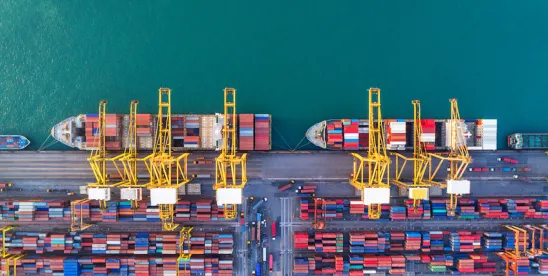Some importers are finding, to their surprise, that the Trump Administration’s 25% tariffs on aluminum and steel create an exemption from the 125% tariffs on Chinese goods.
The Trump tariff agenda has been complex, to say the least. But as with any complex system, it is important to pay attention to the details.
The detail we focus on today is that goods subject to the 25% Section 232 steel and aluminum tariffs, regardless of the steel and aluminum content, are exempt from the “reciprocal” tariffs imposed under the International Emergency Economic Powers Act (IEEPA). For imports from most countries, this is a bad thing (since the IEEPA tariff is currently 10% for most countries, so the 25% Section 232 tariff is much worse). But for goods from China (which are subject to a 125% reciprocal tariff), the 25% steel and aluminum tariffs are actually a relief.
This outcome is unlike most of the other Trump Administration tariff programs, which may be additive with one another in certain circumstances. Here is the rare case where it may be beneficial to have two tariffs that could potentially apply to your goods.
Here is how it breaks down:
- The original reciprocal tariff order exempted Section 232 goods. These tariffs were issued by Executive Order (EO) 14257 on April 2, 2025. The reciprocal tariff EO contained the following provisions:
- Goods from virtually all countries were subject to a “reciprocal” tariff at what was referred to as the “baseline” tariff rate of 10% ad valorem (i.e., 10% of the declared value of the goods).
- Among other exemptions, articles subject to the Section 232 steel and aluminum tariffs were exempt from the 10% baseline rate. Sec. 3(b) of the EO states that “the following goods as set forth in Annex II to this order, consistent with law, shall not be subject to the ad valorem rates of duty under this order: . . . (ii) all articles and derivatives of steel and aluminum subject to the duties imposed pursuant to section 232 [as amended].”
- The baseline tariffs were intended to be raised to higher levels on a country-specific basis (as listed in Annex I of the order) on April 9, 2025.
- President Trump’s April 9, 2025 “pause” order maintained 10% reciprocal tariffs on most countries, but imposed a 125% reciprocal tariff on Chinse goods. The order left untouched the critical provision exempting Section 232 goods from all reciprocal tariffs.
- Guidance issued by U.S. Customs and Border Protection (CBP) on April 4 and modified on April 9, 2025 clarifies that the Section 232 goods remain exempt from the reciprocal tariffs. The guidance provides as follows:
- EXCEPTIONS:
- “Until further notice, for all imported merchandise that is entered for consumption [after certain effective dates], then one of the following HTSUS secondary classifications must be declared, to specify the particular exception pursuant to which the reciprocal tariff in heading 9903.01.25 [the 10% tariff] or 9903.01.43 – 9903.01.76 [the country-specific tariffs] does not apply to the imported articles that are excluded from the additional ad valorem duties:…”
- One of the exceptions is goods that fall under HTS “9903.01.33: Articles of iron or steel, derivative articles of iron or steel . . . of any country, subject to Section 232 actions.”
- EXCEPTIONS:
- Further CBP guidance issued on April 10, 2025 provided additional clarity exempting Section 232 steel and aluminum articles from the 125% China reciprocal tariff. It states:
- “GUIDANCE: Imported products of China. . . other than those that fall within the identified exceptions included in [the April 9, 2025 guidance], entered for consumption, or withdrawn from warehouse for consumption [after effective date], are subject to the following HTSUS classification and additional ad valorem duty rate: 9903.01.63: Articles the product of China, including products of Hong Kong and Macau, will be assessed an additional ad valorem rate of duty of 125%.”
- HTS 9903.01.33 falls under an identified exception in the April 9, 2025 guidance.
- CBP FAQs issued on April 28, 2025 further clarify that goods subject to the 25% Section 232 steel and aluminum tariffs, regardless of the steel and aluminum content, are wholly exempt from the 125% tariff currently applied to imports from China.
- Are importers expected to pay the reciprocal tariff on the value not declared as the steel content – and how would that be determined? Would the importer need to report an additional line for the non-steel value that may be subject to the reciprocal tariffs?
- No, articles and derivatives of steel and aluminum subject to Section 232 duties are excluded from the reciprocal tariffs; pursuant to heading 9903.01.33, HTSUS. Refer to 90 FR 15041 (Apr. 7, 2025) and CSMS # 64680374 and # 64701128.
- In looking at Annex III examples below, is the interpretation correct that the entire value is exempt from reciprocal tariffs and the country rate would not apply regardless of the iron, steel or aluminum content (as applicable in the derivative product)?
- Examples:
- (vii) The additional duties imposed by headings 9903.01.25, 9903.01.35, 9903.01.39, and 9903.01.43-9903.01.77 shall not apply to derivative iron or steel products provided for in headings 9903.81.89, 9903.81.90, 9903.81.91, 9903.81.92 and 9903.81.93.
- (ix) The additional duties imposed by headings 9903.01.25, 9903.01.35, 9903.01.39, and 9903.01.43-9903.01.77 shall not apply to derivative aluminum products provided for in headings 9903.85.04, 9903.85.07, 9903.85.08 and 9903.85.09
- Correct, in the scenarios above, the entire value is exempt from the reciprocal tariffs.
Taken together, the Executive Orders and related CBP guidance establish that if an article from China is subject to the 25% steel and aluminum tariff, it is exempt from the 125% reciprocal tariff for articles from China.
Moreover, depending on the type of article, the 25% Section 232 steel and aluminum tariff will either apply to the entire value of the article or only to its steel or aluminum content. We described how the Section 232 steel and aluminum tariffs apply in previous blog post. This means that in most cases the 25% tariff will only apply to the value of the steel or aluminum content, and not to the entire value of the good.
We note that other tariffs still apply (and apply to the whole value of the imported good). For example, all goods of China are still subject to the 20% tariff imposed March 3, 2025 related to the Fentanyl economic emergency. Additionally, there are tariffs on certain steel products from China under Section 301.
One further twist is what to do when the imported article is identified on the Section 232 steel and aluminum tariff order (by Harmonized Tariff number) but actually contains no steel or aluminum. Would those goods be exempt from the reciprocal tariff? That depends on what the term “regardless of the iron, steel or aluminum content”in the CBP FAQ means. On its face, “regardless” could be taken to mean that the article could contain zero percent iron or steel. If that article is nonetheless listed in the Section 232 order, and also is a product of China, some importers are taking the position that such an article is exempt from the China reciprocal tariff and also draws zero Section 232 duty (because the 232 duty applies only to the steel or aluminum content). The risk here is whether CBP might consider the article with zero aluminum or steel not to be “subject” to the 232 duty, even though it is listed in the Section 232 order.
We also note that importers always bear the duty of “reasonable care” in declaring the correct classification, value, origin, tariff program applicability, and all other aspects of the importation, under penalty of law. Therefore, it is crucial to ensure accuracy in these matters.




 />i
/>i
